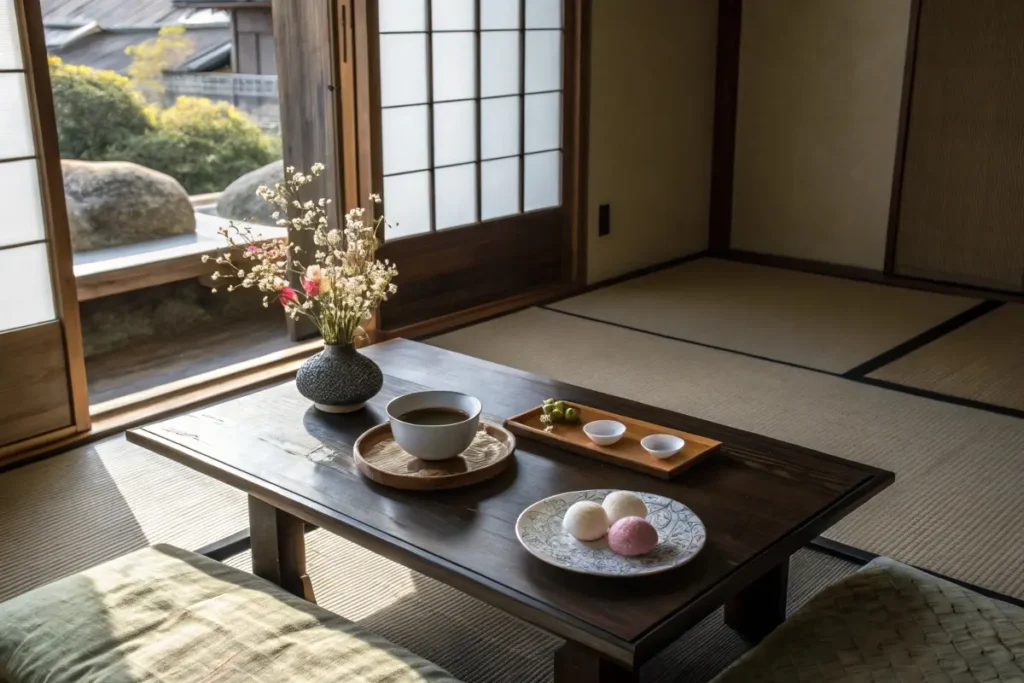When we think about dessert in Japanese culture, many delightful images come to mind: delicate wagashi served during a tea ceremony, airy soufflé pancakes stacked high in trendy Tokyo cafés, or the quirky fish-shaped taiyaki stuffed with sweet bean paste. But how do you actually say dessert in Japanese, and what does it encompass? In Japanese, dessert can be called デザート (dezāto)—often borrowed from English—or 甘味 (kanmi) in a more traditional sense. Yet the popular Japanese desserts you encounter span a wide spectrum, from the super-sweet purin pudding to subtle, bean-based confections. This article explores everything from what is dessert called in Japan, what is dessert in Japanese, to the deeper nuances of purin in Japanese and its cultural significance.
For a broader selection of sweet treats, you can also visit our Japanese Dessert Recipes page. Whether you crave something authentically local like dorayaki or a modern twist like matcha tiramisu, you’ll find a blend of tradition and innovation. Let’s delve into the vibrant world of Japanese dessert ideas, unraveling how centuries-old practices merge with global influences, forming an ever-evolving tapestry of flavors and textures.
Introduction
Sweetness in Japan is more than just sugar. It’s intricately tied to cultural traditions, seasonal awareness, and regional specialties. While dessert in Japanese is frequently referred to as デザート (dezāto)—a direct loanword from English—traditional terms like 甘味 (kanmi) and お菓子 (okashi) also cover confections and snacks. The line between dessert and snack can be fluid, but each treat holds a special place, whether it’s served at a tea ceremony or found at your local convenience store.
Over the last few decades, Japanese desserts have captured global attention. Tokyo pastry shops combine French pastry techniques with local flavors like matcha or azuki bean paste. Meanwhile, classic wagashi remain popular during festivals and family gatherings, bridging cultural rituals with sweet indulgence. Yet, beyond culinary complexity, the concept of dessert in Japanese also reflects a mindful approach—often offering smaller portions, moderate sweetness, and an artistic presentation.
Interested in mastering these delicacies at home? Check out our Japanese Desserts Recipe collection. You’ll see how mochi-making or whipping up a luscious green tea cake can be surprisingly accessible. From the humble purin (Japanese pudding) to elaborate layered parfaits, the realm of Japanese desserts invites you to explore artistry, flavor balance, and a touch of history in every bite.
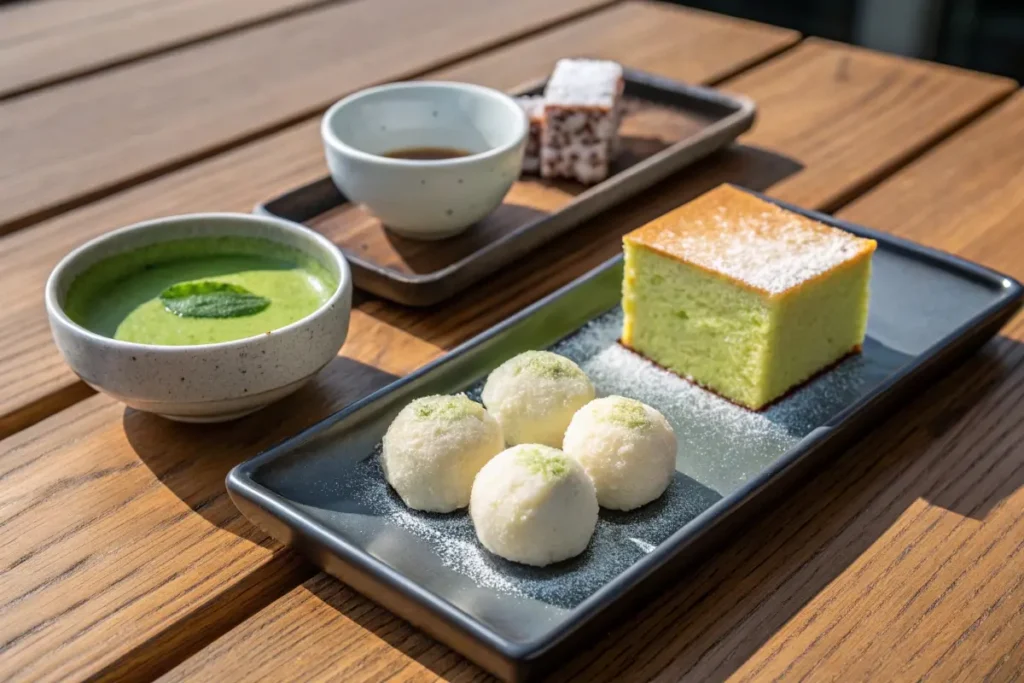
Understanding Dessert in Japanese
1. The Language of Dessert in Japan
Dessert in Japanese typically appears as デザート (dezāto), a loanword from English. However, traditional confections—often referred to as wagashi—occupy a distinct category within the broader sweet landscape. You might also hear the term 甘味 (kanmi) specifically referencing sweetness or sweet courses. So what does each term signify?
- デザート (dezāto): This covers Western-style sweets like cake slices, ice cream sundaes, or pudding served after a meal.
- 甘味 (kanmi): More colloquial, often used in the context of local sweet shops or cafés focusing on old-school treats like anmitsu or dango.
- お菓子 (okashi): A broader term for snacks, sweets, or candy. It can span sweet biscuits, savory crackers, or candy bars.
2. Modern Dessert Culture: Where Eastern and Western Meet
Today, a typical Japanese dessert menu might feature both classic Japanese sweets and Western pastries. Restaurants and cafés often present delicate pastries, matcha parfaits, or a famed Tokyo specialty like soufflé pancakes. In convenience stores, you’ll find individually wrapped cream puffs, Swiss rolls, or even small Mont Blancs, showcasing how integral sweet treats are to everyday life.
Dessert in Japanese also extends to café culture. Urban cafes might specialize in:
- Matcha Lattes with latte art, occasionally accompanied by mochi or warabi dumplings.
- Japanese Cheesecakes: Light, fluffy variations reminiscent of a soufflé, called rare cheesecake or baked cheesecake in local parlance.
- Hybrid Creations: E.g., mochi doughnuts or donuts stuffed with red bean paste, bridging sweet pastry and wagashi influences.
3. The Role of Seasonality
Seasonality is crucial. Cherry blossom–flavored desserts arrive in spring, refreshing citrus (like yuzu) in summer, sweet potato confections in autumn, and chestnut desserts in winter. This cycle parallels the overarching Japanese principle of celebrating nature’s fleeting moments in one’s culinary choices. Even store-bought desserts often carry a seasonal twist—like sakura mochi around April or kabocha pudding during fall.
4. Notable Long-Tail Keywords
If you’re seeking deeper categories, you might search for terms like:
- “popular japanese desserts” for mainstream favorites like mochi or taiyaki.
- “japanese sweet food” for general references to items beyond formal dessert courses—like pancake sandwiches or melon pan.
- “japanese dessert recipes” for specific how-tos on mochi, roll cakes, and more.
- “japanese dessert names” to understand each item’s identity or historical background.
Throughout these categories, purin in Japanese emerges as a distinct star. Purin (プリン) is essentially a custard pudding shaped like a flan, often with a caramel topping. Its popularity spans generations, with variations in many home kitchens and high-end shops. Additionally, matcha desserts or fruit-based jellies also remain evergreen in popularity, each connecting with Japan’s preference for balanced sweetness.
For more background, see our Traditional Japanese Desserts Recipe, where we delve into wagashi fundamentals—mochi dough, bean paste shaping, and the significance behind their seasonal presentations. Combining local traditions with modern influences, dessert in japanese stands as a testament to adaptability, taste, and a deep-seated cultural inclination toward artistry in every sweet creation
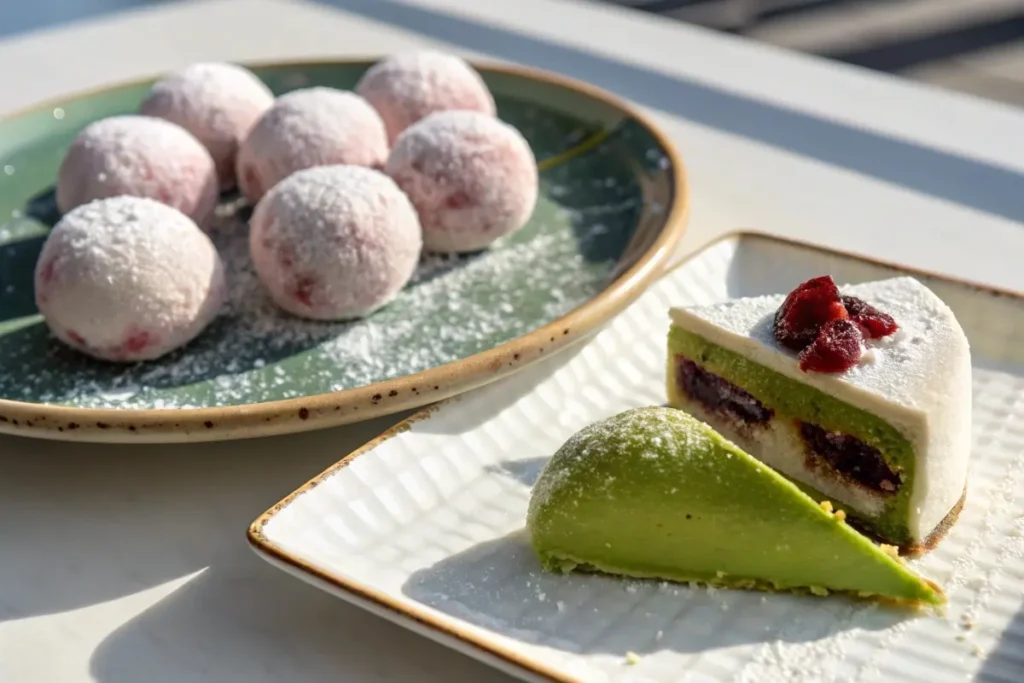
Popular Desserts and Pastries in Japan
1. Iconic Traditional Sweets
Mochi: Possibly the best-known “dessert in Japanese” communities. This sticky rice cake can appear in multiple forms: daifuku (stuffed with sweet bean paste), sakura mochi (cherry blossom–flavored), or kusa mochi (with mugwort flavor). The mouthfeel—soft, slightly chewy—tends to be a novel surprise for newcomers.
Dorayaki: Two fluffy pancakes sandwich a layer of anko. Easy to carry, it’s a standard snack/dessert found across Japan.
Taiyaki: Shaped like a fish (tai), these waffle-like pastries often hold sweet bean paste, custard, or chocolate filling. Modern variants feature ice cream and toppings.
2. Beloved Modern Pastries
Soufflé Pancakes: These jiggly towers have soared in popularity globally. Whipped egg whites give them a light, airy structure.
Cheesecakes: Japan’s signature is the airy “rare cheesecake” (no-bake, set with gelatin) and the cotton-soft baked cheesecake. Often served chilled with minimal sugar.
Cream Puffs (シュークリーム): French-inspired but widely embraced in Japan, stuffed with whipped cream, custard, or seasonal fruit fillings.
3. Purin (プリン): The Ubiquitous Custard
Purin in Japanese refers to a simple, flan-like custard dessert with a caramel sauce top. Its texture is firm enough to hold shape but still melts away sweetly. From homemade versions to store-bought single-serve cups, purin is an everyday indulgence. Gourmet shops elevate it by using premium eggs or special caramel drizzles.
4. Tokyo Trends and Cafe Specialties
In Tokyo, dessert fads shift quickly:
- Matcha Parfaits layered with azuki, mochi, cornflakes for crunch, and whipped cream.
- Soft Serve in unusual flavors (like sake, sakura, or black sesame) swirling onto a crispy cone, sometimes finished with gold leaf.
- Seasonal Mont Blanc: Inspired by the French chestnut dessert, but topped with a swirl of sweet potato or matcha-tinged paste.
5. Savory-Meets-Sweet and Fusion Items
A rising phenomenon is dessert in japanese cuisine that merges sweet and savory. For instance, cheese tarts might integrate a hint of miso for a deeper umami. Mitarashi dango, though sweet, includes a salty soy sauce glaze. This interplay resonates with Japanese food philosophy—balancing flavors across the palate.
For comprehensive how-tos on big hits like taiyaki or dorayaki, see our Japanese Dessert Recipes for step-by-step instructions. Understanding the basics of mochi dough or anko filling opens the door to multiple variations. From a practical standpoint, you’ll notice that many of these sweets rely on a handful of staple ingredients—rice flour, bean paste, eggs, sugar—transformed in creative ways to form an astonishing variety of tastes and textures.
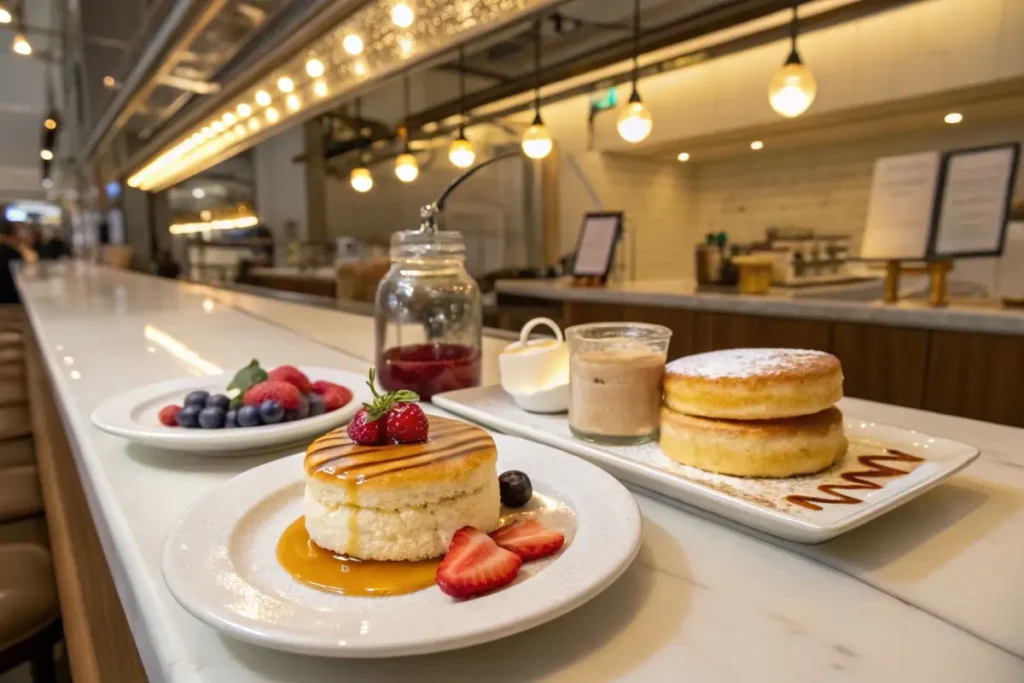
History and Examples
1. Edo-Era Foundations
Before “dessert” was a formal course, Japan enjoyed sweet snacks or confections known as kashi. The Edo period (1603-1868) was pivotal in popularizing sugar among the urban populace. Merchants and commoners indulged in simpler versions of today’s sweets—like early types of mochi or the forerunner to dorayaki. Tea houses spurred demand for confections that balanced the bitterness of green tea.
2. Meiji to Pre-War Western Influence
The Meiji Restoration in 1868 opened Japan to Western ways, including pastries, cakes, and puddings. Many dessert in japanese references we see today—like “custard pudding” or “cream puff”—trace back to this era’s assimilation. Shops in Tokyo began replicating French or German cakes, often sweetened less aggressively, with local touches (matcha or sweet bean paste). Some recipes from that period remain deeply cherished, e.g., castella cake introduced by Portuguese missionaries, refined over generations.
3. Post-War Dessert Boom
After WWII, Japan’s economy soared, allowing sweets to become everyday indulgences rather than luxury items. The 1970s-80s saw conbini (convenience stores) flourish, offering single-serving puddings, cakes, and novelty items to cater to on-the-go lifestyles. Television cooking shows and magazines mainstreamed home baking—a shift from wagashi to also focusing on yōgashi (Western sweets). Softness and fluffiness became hallmark textures, from the iconic chiffon cakes to cloud-like cheesecakes.
4. 21st Century Innovations
Today, dessert in japanese contexts merge tradition with global inspiration. Tokyo’s top patissiers experiment with matcha croissants, mochi donuts, or yuzu-laced brownies. Freed from older norms, wagashi artisans also adopt modern design to reinvigorate classic treats like yokan with bright colors or shaped motifs. Seasonal exclusivity fuels fan excitement—like the arrival of sakura mochi each spring. Meanwhile, social media spurs “must-try” fads, from stuffed taiyaki cones to flamboyant bubble teas.
Cultural Symbolism: Desserts remain integral to festivals—think hanami dango for cherry blossom viewing—and symbolic gifts, embodying Japan’s “omiyage” (souvenir) tradition. Even everyday pastries might reflect the ephemeral nature of seasonal produce or replicate motifs from pop culture.
For direct reference to these evolving sweet customs, try our Japanese Cookies for a small sampling that merges comfort baking with local twists. The continuum from Edo’s early sugar adoption to modern flair underscores how dessert in japanese is dynamic, bridging centuries of refinement with playful contemporary expressions. Each treat—whether mochi-laden or cream-based—carries a historical imprint, forging a sweet link between past and present.
Practical Examples/Use Cases
1. Homemade Mochi Gathering
Scenario: You’re hosting a cultural dinner party at home, wanting to offer a quintessential dessert in japanese style.
- Approach: Make homemade mochi—steamed glutinous rice or microwave mochi kits—to shape daifuku stuffed with sweet bean paste or fruit.
- Value: Guests appreciate a hands-on experience, learning how a simple combination of rice flour and water becomes a chewy, sweet delight.
2. Cafe Entrepreneurs
Scenario: A small café aims to differentiate with Japanese-inspired desserts.
- Approach: Offer a rotating seasonal menu: matcha roll cake in spring, kakigori shaved ice in summer, sweet potato pies in autumn, and chestnut Mont Blanc in winter.
- Outcome: Loyal customers seeking variety and unique flavors become repeat visitors, driving engagement across seasons.
3. School or Community Events
Scenario: For cultural appreciation day at a local community center.
- Approach: Present a tasting booth with mochi squares, mini dorayaki, and small cups of purin. Provide short notes on each dessert’s background.
- Benefit: Participants enjoy an accessible introduction to Japanese sweets, bridging educational context with flavorful samples.
4. Traveling Foodies
Scenario: A trip to Tokyo or Kyoto, searching for authentic dessert experiences.
- Approach: Pinpoint top wagashi shops near temples or shrines, sampling fresh namagashi crafted daily. Visit modern patisseries in the city center for matcha eclairs or mochi donuts.
- Reward: Savor a broad scope of dessert culture—both time-honored staples and new wave innovations.
For simpler recipes bridging savory-sweet boundaries, check out our Japanese Chicken Fried Rice Recipe for a hearty main dish preceding your mochi dessert finale. Combining such meal ideas merges practicality with a taste of Japan’s eclectic table. With a bit of curiosity, dessert in japanese becomes accessible anywhere—kitchens, cafés, or international travel destinations.
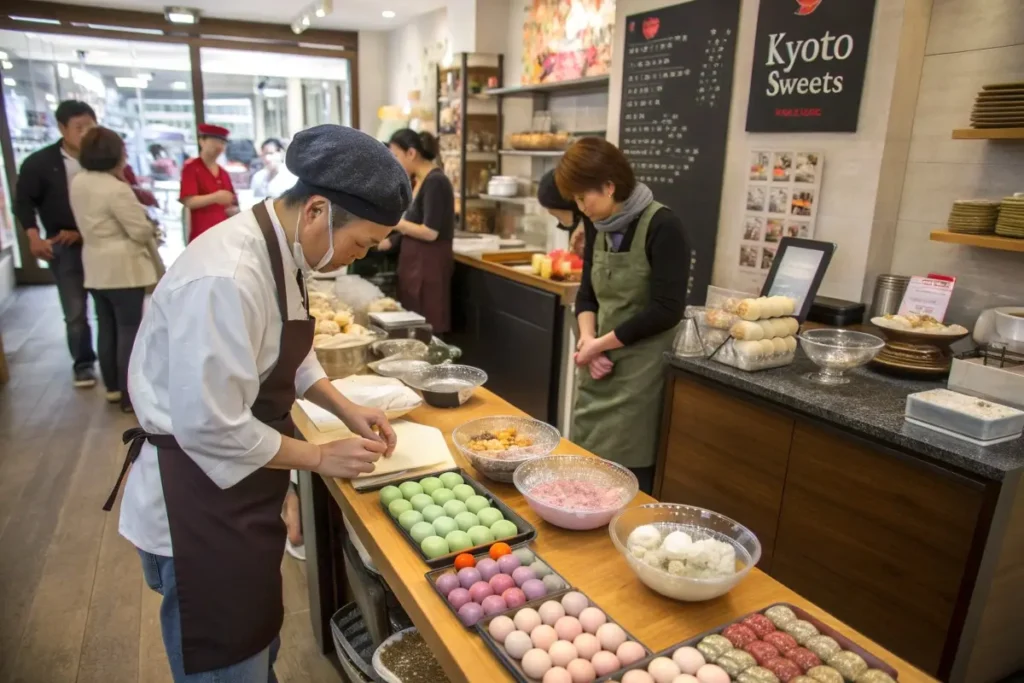
FAQs
1. What is dessert called in Japan?
In everyday speech, people often say デザート (dezāto) for Western-type sweets or the final course. Traditional sweets might be referred to as 甘味 (kanmi) or お菓子 (okashi), especially wagashi. Context matters: in a café, you might see “dessert set” labeled in katakana, while wagashi shops might only say kanmi.
2. What is dessert in Japanese?
The direct translation is “デザート” (dezāto). However, wagashi-based confections—mochi, red bean sweets, or jelly-like yokan—are frequently in a different category. They can appear as part of a meal or snack rather than a formal “dessert” course.
3. What is purin in Japanese?
Purin (プリン) refers to a custard pudding similar to flan. Typically, it’s an egg-custard base with a caramel sauce. Homemade or store-bought purin is quite popular, often found in small plastic cups with a jiggly top layer of caramel.
4. What is the translation of dessert?
“Dessert” in a broad sense translates to デザート (dezāto) if referencing Western sweets or after-meal treats. However, for something more tradition-anchored or snack-like, terms like 甘味 (kanmi) might be used, capturing the nuance of local sweet foods or wagashi.
5. Are Japanese desserts generally less sweet?
Yes. Japanese desserts often emphasize subtlety, ensuring flavors like matcha, bean paste, or fruit remain noticeable instead of overshadowed by heavy sugar. The sweetness is typically moderate, aiming for harmonious balance with teas or other savory dishes.
6. Which desserts are recommended for beginners?
Mochi or dorayaki are straightforward to make. Even purin has accessible recipes—just eggs, milk, sugar, and a caramel layer. For more adventurous pastry attempts, try matcha roll cakes, which require basic sponge-baking skills.
7. Where can I learn more about making Japanese desserts?
Start with our Japanese Dessert Recipes. Some recipes incorporate video tutorials or step-by-step photos. Also, local cultural workshops or Japanese grocery stores might offer beginner kits for mochi or anko-based sweets.
Conclusion
Dessert in Japanese culture weaves together tradition, innovation, and linguistic nuance. Whether you say デザート (dezāto) for Western-style sweets or お菓子 (okashi) for a broader category, Japanese confections reflect a deep reverence for seasonality and subtle tastes. Wagashi—crafted from rice flour, bean paste, or agar—coexists with Western pastries shaped by local flavors like matcha or yuzu. Meanwhile, purin remains a humble but beloved pudding that crosses generations and backgrounds.
To begin your own journey, pick a dessert that resonates with your taste or skill level: perhaps a simple mochi, a creamy purin, or a fluffy soufflé pancake. For step-by-step guides, our Japanese Dessert Recipes provide helpful introductions—covering everything from anko making to layering airy cheesecakes. As you explore these sweets, remember the guiding principle behind many Japanese culinary creations: balanced sweetness, refined presentation, and a respect for natural flavors.
In essence, dessert in japanese underscores a warm synergy between heritage and adaptation—a reminder that small, artful indulgences can carry a world of cultural insight. With each bite, you taste history, creativity, and the ongoing fusion of East and West. So, gather your ingredients, embrace the technique that suits you best, and savor the delightful realm of Japanese confections, one sweet morsel at a time.
